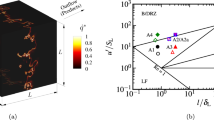Abstract
The laminar burning velocity of syngas-air premixed flames was measured with various equivalence ratios from 0.5 to 5.0 and a mole fraction of H2 from 0.05 to 0.75. The laminar burning velocity was experimentally determined using a Bunsen flame according to the cone angle and surface area methods. A premixed code with a USC-II detailed reaction mechanism was used for the numerical calculations to predict the laminar burning velocity and to examine the relationship between the burning velocity enhancement and the hydrogen- related reactions. The results indicate that an appropriate method for the measurement of laminar burning velocity is necessary in the H2/CO/air syngas premixed flame. In addition, the burning velocity linearly increased with the increase of the H2 mole fraction in the syngas mixture, although the burning velocity of H2 was 10 times larger than that of CO. This result is attributed to the rapid production of H-radicals at the early stage of combustion. Furthermore, the predicted mole fractions of H and OH radicals increased with the increase of H2 mole fraction for a lean syngas mixture. However, the mole fraction of OH radicals, an indicator of heat release rate, decreased for rich syngas mixture, resulting in a reduction of the laminar burning velocity, even with an increase of the H2 mole fraction.
Similar content being viewed by others
References
B. Yu, S. M. Kum, C. E. Lee and S. Lee, Effects of exhaustgas recirculation on the thermal efficiency and combustioncharacteristics for premixed combustion system, Energy, 49(2013) 375–83.
B. Yu, S. M. Kum, C. E. Lee and S. Lee, Study on the combustioncharacteristics of a premixed combustion systemwith exhaust gas recirculation, Energy, 61 (2013) 345–53.
H. Sun, S. I. Yang, G. Jomaas and C. K. Law, Hig-pressurelaminar flame speeds and kinetic modeling of carbon monoxide/hydrogen combustion, Proc. Combust. Inst., 31 (2007) 439–46.
C. Prathap, A. Ray and M. R. Ravi, Investigation of nitrogendilution effects on the laminar burning velocity and flamestability of syngas fuel at atmospheric condition, Combust. Flame, 155 (2008) 145–60.
N. Bouvet, C. Chauveau, I. Gokaip and F. Halter, Experimentalstudies of the fundamental flame speeds of syngas(H2/CO)/air mixtures, Proc. Comb. Inst., 33 (2011) 913–920.
C. M. Vagelopoulos and F. N. Egolfopoulos, Laminar flamespeeds and extinction strains rates of mixtures of carbonmonoxide with hydrogen, methane, and air, Symp. Combust.Proc., 25 (1994) 1317–1323.
J. Natarajan, T. Lieuwen and J. Seitzman, Laminar flamespeeds of H2/CO mixtures: effect of CO2 dilution, preheattemperature, and pressure, Combust. Flame, 151 (1-2)(2007) 104–119.
C. Dong, Q. Zhou, Q. Zhao, Y. Zhang, T. Xu and S. Hui, Experimental study on the laminar flame speed of hydrogen/carbon monoxide/air mixtures, Fuel, 88 (10) (2009) 1858–1863.
N. Bouvet, C. Chauveau, I. Gokaip, S. Y. Lee and R. J. Santoro, Characterization of syngas laminar lames using theBunsen burner configuration, Int. J. Hydrog. Energy, 36 (2011) 992–1005.
J. Fu, C. Tang, W. Jin, L. D. Thi, Z. Huang and Y. Zhang, Study on laminar flame speed and flame structure of syngaswith varied compositions using OH-PLIF and spectrograph, Int. J. Hydrog. Energy, 38 (2013) 1636–1643.
H. J. Burbano, J. Pareja and A. A. Amell, Laminar burningvelocities and flame tability analysis of syngas mixtures atsub-atmospheric pressures, Int. J. Hydrog. Energy, 36 (2011) 3243–3252.
E. Hu, J. Fu, L. Pan, X. Jiang, Z. Huang and Y. Zhang, Experimental and numerical study on the effect of compositionon laminar burning velocities of H2/CO/N2/CO2/air mixtures, Int. J. Hydrog. Energy, 37 (2012) 18509–18519.
Y. He et al., Investigation of laminar flame speeds of typicalsyngas using laser based Bunsen method and kineticsimulation, Fuel, 95 (2012) 206–213.
R. J. Kee, J. F. Grcar, M. D. Smooke and J. A. Miller, AFortran program for modeling steady laminar onedimensionalpremixed flame, SAND85-8240 (1994).
R. J. Kee, F. M. Rupley and J. A. Miller, Chemkin-II: aFortran chemical kinetics package for the analysis of gasphase chemical kinetics, SAND89-8009B (1989).
R. J. Kee, G. Dixon-Lewis, G. J. Warnatz, M. E. Coltrinand J. A. Miller, A Fortran computer code package for theevaluation of gas-phase multi-component transport, SAND86-8246 (1994).
H. Wang et al., USC Mech Version II. High-temperatureCombustion Reaction Model of H2/CO/C1–C4 Compounds,http://ignis.usc.edu/USC_Mech_II.htm, May (2007).
M. I. Hassan, K. T. Aung and G. M. Faeth, Properties oflaminar premixed CO/H2/air flames at various pressures, J. Propul. Power, 13 (1997) 239–245.
M. P. Burke, X. Qin, Y. Ju and F. L. Dryer, Measurementof hydrogen syngas flame speeds at elevated pressure, 5thUS Combustion Meeting, San Diego, March (2007) 25–28.
Y. Hardalupas and M. Orain, Local measurements of thetime-dependent heat release rate and equivalence ratio usingchemiluminescent emission from a flame, Combust. Flame, 139 (2004) 188–207.
C. K. Westbrook and F. L. Dryer, Chemical kinetic modelingof hydrocarbon combustion, Progress in Energy andCombustion Science, 10 (1984) 1–57.
Author information
Authors and Affiliations
Corresponding author
Additional information
Recommended by Associate Editor Jeong Park
Kee-Man Lee received his B.S. and M.S. degrees in Mechanical Engineering from Inha University, Korea in 1983 and 1986, respectively. He received a Ph.D. degree from KAIST in 1998. Dr. Lee is currently a professor at the School of Mechanical and Aerospace Engineering in Sunchon National University, Korea. He is currently on the Editorial Board of the Korean Society of Combustion. His research interests are in the area of swirl stabilized combustion, synthetic gas combustion and laser diagnostics.
Seungro Lee received his B.S. and M.S. degrees in Mechanical Engineering from Inha University, Korea in 1998 and 2000, respectively. He then received his Ph. D. degree from University of Southern California, USA in 2008. He is currently an Assistant professor at the Department of Mechanical Engineering in Chonbuk National University, Korea. His research interests are in the area of high efficiency and low emission combustion system, alternative fuels and flow visualization.
Rights and permissions
About this article
Cite this article
Lee, KM., Jeong, B. & Lee, S. Study on laminar burning velocity of syngas-air premixed flames in various mixing conditions. J Mech Sci Technol 29, 3005–3015 (2015). https://doi.org/10.1007/s12206-015-0631-y
Received:
Revised:
Accepted:
Published:
Issue Date:
DOI: https://doi.org/10.1007/s12206-015-0631-y




